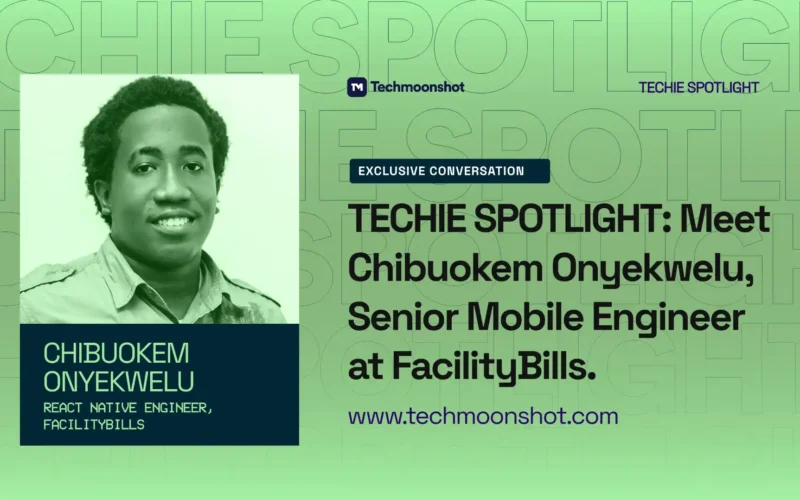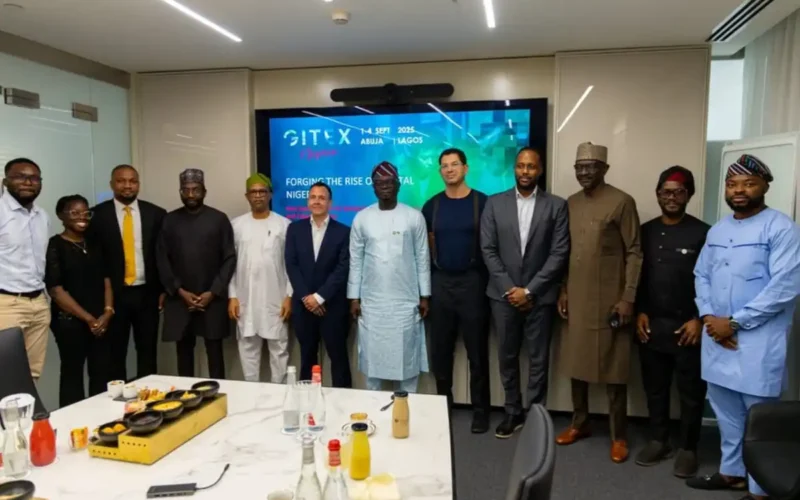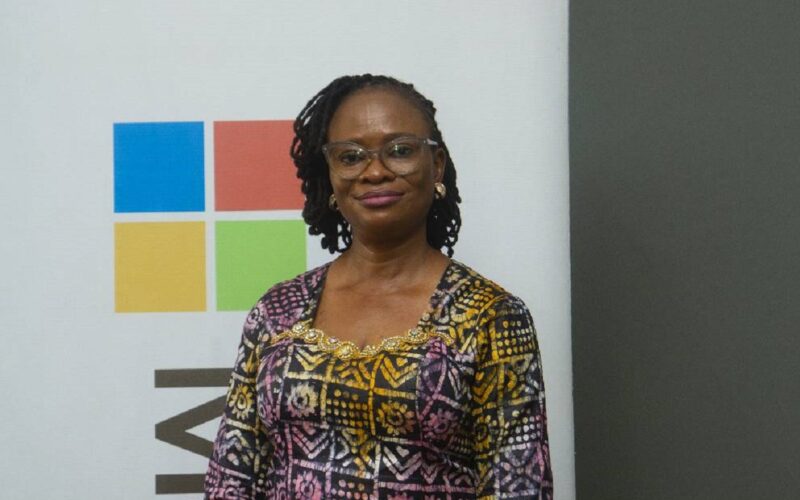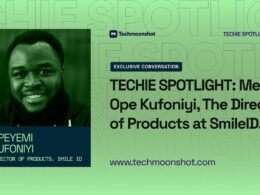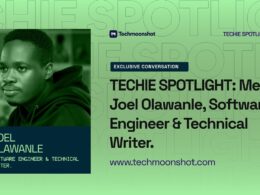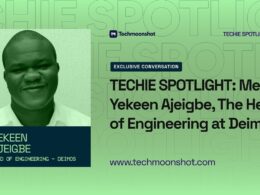Chibuokem Onyekwelu’s journey into programming began at the age of 16, sparked by the influence of his mother—a computer scientist who nurtured his curiosity despite the challenges of raising a young family.
She introduced him to HTML, and what started as a simple lesson quickly evolved into a deep fascination with web development. Chibuokem became captivated by the ability to bring ideas to life through code. From crafting basic pages, he expanded into CSS, JavaScript, backend technologies, and eventually mobile development.
Driven by self-motivation and relentless curiosity, he spent years building personal projects, experimenting with new tools, and learning through hands-on experience. His dedication led him from self-directed learning to professional work—starting with freelance gigs and progressing into full-scale development roles.
Today, Chibuokem is a seasoned web and mobile engineer known for his ability to design thoughtful, user-centered solutions. He credits his mother’s early encouragement as the catalyst for a career that blends technical depth with creative ambition—proof that one small spark can ignite a lifelong passion.
In this exclusive conversation, Chibuokem opens up about his journey, the power of mentorship, and how early curiosity became the foundation of his career in tech.
Can you share your path into software engineering—what drew you to mobile development and React Native?
My passion for programming began when I was 16 years old, thanks to my mother’s influence and guidance. My mom was a computer scientist who had just graduated from secondary school when she first introduced me to the world of technology. Despite having young children to care for and facing various challenges, she managed to balance her responsibilities while nurturing my interest in coding.
It all started when she introduced me to HTML, which became my gateway into web development. I was immediately fascinated by the ability to create websites and see my code come to life in a browser. What began as simple HTML pages soon evolved into a deeper exploration of web technologies.
Over the next couple of years, I spent countless hours experimenting with different programming languages and frameworks. I dove into CSS for styling, learned JavaScript for interactivity, and gradually expanded my knowledge to include backend technologies. Each new technology I encountered opened up new possibilities and fueled my curiosity even more.
During this period of exploration, I worked on various personal projects, built small websites, and continuously challenged myself to learn more advanced concepts. The learning process was both exciting and demanding, but my passion for creating digital solutions kept me motivated.
Coffee or tea—and what’s your go-to order while coding?
don’t have a strong preference, but I usually start my day with a cup of coffee — especially when I’m settling into work or heading to a café. Throughout the rest of the day, though, I tend to prefer tea.
As for my go-to order while coding, I typically go for something quick and light, like a sandwich. I don’t really enjoy eating full meals while working, so I prefer something I can eat quickly and get back to work. If I’m going to have a proper meal, I usually save that for a break — like during lunch — rather than while I’m actively working.
You’re building apps used by 100K+ users globally—what’s the first time you realized your work was making waves?
When I joined Female Invest, I came on board to help build and shape the early version of the product. I spent the first few months working on the MVP, focusing on getting the core functionality right. Once we had the initial version of the app ready, we released it quietly and began user testing with a small group.
What surprised us was how quickly it began to grow — and this was purely organic. We hadn’t done any advertising, marketing, or formal outreach. People were simply discovering the app, downloading it, and engaging with it. By the time we officially announced the launch, we already had 16,000 users. It was an exciting and validating moment, especially considering the minimal promotional effort we had put in at that stage.
I had worked on other digital products before, but this was different in terms of traction and user engagement. Over the next 12 months, the momentum continued. Our user base kept growing, and eventually, we reached over 80,000 users. Even more impressive was that over 46% of them were active daily — a strong signal that we were solving a real problem and creating value for our users.
As a Senior React Native Engineer, what’s the most complex app challenge you’ve tackled recently?
To give a bit of background, Female Invest is a platform that combines educational content with a trading simulator. The core mission was to bridge the gender gap in investing and personal finance by making financial education more accessible, especially for women.
We had a rich library of learning materials, but we wanted to make the experience even more engaging and practical. So, we decided to integrate interactive learning elements directly into the app, particularly within the trading simulator. This included adding quizzes and step-by-step walkthrough flows that would guide users through various actions. For example, we created flows where a pointer would highlight parts of the screen, explaining what would happen if the user clicked a certain button — such as how to buy a stock within the simulator.
One specific flow walked users through the process of selecting a stock, interpreting its performance data, and understanding the functionality of each button involved in executing a trade. It was all about making the learning experience hands-on and intuitive.
One of the biggest challenges I faced was that we were building on top of a core feature that was already actively being used by many users. So there was always the concern about causing regressions or breaking existing functionality. Beyond the technical complexity, this was also my first time working on this kind of interactive feature. It required a lot of learning, experimentation, and iteration on my part.
I spent a couple of months on the design and implementation, and by the time the feature was completed, it was incredibly fulfilling to see it come to life. It not only enhanced the learning experience for users but also marked a significant growth milestone in my own journey as a product builder.
How do you optimize for performance and user experience on React Native across different devices?
Yeah, so this is a major talking point within the community. We have both iOS and Android operating systems, but Android, in particular, has a wide range of device manufacturers — like Samsung, Google, and others. Each of these handles things like background tasks, memory optimization, and system behavior differently, which can affect app performance.
There are some established best practices to help with performance — things like preventing unnecessary renders, being cautious with how many useEffect hooks you use, and properly optimizing useEffect and useState. It’s also helpful to memoize components using useCallback or useMemo to avoid re-renders when they’re not needed.
After developing a feature, it’s important to profile the components you’ve built to check for memory leaks or anything that might be causing drops in JS frame rates. Personally, I use the React Native Debugger, which includes a profiling tool that’s been really helpful.
It’s also good practice to implement caching so that the app doesn’t have to make API calls every single time you need to fetch data. That not only improves performance but also enhances the user experience.
Speaking of which, it’s really important to think about the user experience of a feature right from the architecture and planning phase. You want to be sure that what you’re designing truly meets the user’s needs before you even start building. And finally, if you’re building products, I think beta testing and A/B testing are essential. They help you gather real user feedback early on and allow you to refine the product before a full release.
You’re active as a mentor on ADPList—what’s your approach to guiding early-career devs?
So the first thing I’d say to anyone looking to start a career in tech is to really understand where their passion lies. Tech is a broad field with so many different areas — both technical, like writing code, and non-technical roles as well.
I usually advise people to start by doing some research. Are they interested in current trends like AI and machine learning? Or are they more passionate about building products? Once they’ve identified their interests through that research, it becomes easier to guide them toward the right path.
I often recommend starting with a simple programming language like Python or JavaScript. Personally, I began with HTML and CSS, and over time, I explored different areas, learning new languages and technologies along the way. That approach gave me broad exposure — from frontend and backend to mobile development — and it’s helped me a lot in my career.
That said, while it’s great to explore, it’s also valuable to pick one area and go deep. Specializing helps you build expertise and become more effective in that domain. Learn the core skills, practice consistently, and start working on real projects.
Another important thing I emphasize is learning how to do your own research. While I’m always happy to help when someone is stuck, I encourage people to try and find solutions on their own first. It builds independence, ownership, and a deeper understanding of the work you’re doing.
How has giving back shaped your own development and leadership style?
I’ve always been a strong advocate for volunteering and giving back to the community. Right from my time in school, I was involved in a lot of volunteer work. One of the biggest benefits for me has been the connections it creates — you meet a wide range of people, from fellow volunteers to organizers. Those connections often prove valuable later on in your career.
I also see volunteering as a powerful way to give back, especially when supporting people who are just starting out in their careers. Whether it’s teaching a short course, speaking at a seminar, or mentoring, I’ve found that these experiences push me to revisit the basics. It’s like a personal refresher, and it helps me stay consistent with learning and relearning foundational concepts.
Volunteering also adds great value to your profile. Having experience with open-source contributions or community initiatives shows commitment to the growth of the industry and reinforces your impact beyond just the work you do day-to-day.
You also work with full-stack techs—REST APIs, Node.js, databases—how does that depth influence your frontend work?
One of the most important benefits for me, as I mentioned earlier, is having broader experience beyond just frontend development. It gives me a deeper understanding of what’s happening across the entire product — not just building user interfaces.
For instance, when I’m working on a screen, my knowledge of how API endpoints work allows me to contribute more meaningfully. I can suggest better approaches — like recommending a more efficient way to structure data or simplify an integration. This perspective also allows me to be more involved in planning and architecture discussions.
Right now, I’m working toward transitioning into a more product-focused or architectural role. Instead of being limited to frontend tasks, I want to take part in scoping work, making technology decisions, and helping define the overall approach. My experience across the full stack — from backend to frontend and even some design — positions me well to make informed decisions and contribute at a strategic level.
When you adopt a new technology, like Redux or SCSS, what helps you make it production-ready?
I believe it has become relatively easier over time to adopt new technologies, especially as I gain more experience with different products, tools, and tech stacks. The more exposure you have, the quicker you’re able to pick up new concepts.
For me, learning on the job has been the most effective way to adopt new technologies with confidence. Typically, when I come across a new tool or framework — whether through documentation or an online course — the first thing I do is apply it to a real-world scenario, usually through a small personal project. From there, I try integrating it into an actual product I’m working on.
That practical, hands-on approach accelerates the learning process. And as you continue to use the technology, read more about it, and explore best practices, it becomes easier over time to apply it in production with confidence.
You’ve written articles on Medium ranging from design to career reflections—how does writing influence your approach to engineering?
I think writing goes beyond just sharing knowledge or giving back to the community — for me, it’s also a powerful tool for retaining what I’ve learned. Often, when I write, I find myself doing a bit more research to deepen my understanding. It helps me document not only what I’ve learned, but also how I learned it and the approach I took.
This isn’t limited to writing articles; it also includes documenting features I’ve worked on or the technologies I’ve used in a project. Writing, in any form, reinforces learning, allows you to share insights with others, and creates a personal knowledge base you can always refer back to in the future.
As a self-proclaimed “restaurant hopper,” what’s the best meal you’ve had in Lagos recently?
I feel like my answer to this might be influenced by recency bias, but I recently had a burger from Soul Food on the mainland — a soul food restaurant — and honestly, it’s the best burger I’ve had in Lagos. So I’d say that’s the meal I’ve enjoyed the most recently.
I also had some really good chicken wings not long ago, which is one of my favorite things to eat, especially when I’m at home. So overall, I’d say those two have been the best things I’ve had in a while.
How do you, how do you decompress after hitting a tough bug or a tight deadline?
For me, the best way to decompress is simply taking a break. I have a range of activities I usually turn to, depending on how I’m feeling. If I haven’t had a meal yet, I’ll take that time to eat. Sometimes I go for a short walk around my estate, which helps clear my head.
Other times, I might check in on a friend with a quick call, take a nap if I’m really exhausted, or watch a series or movie I’m currently following. I also occasionally play console games — something like Fortnite or others, just to unwind.
More recently, I’ve been trying to be more intentional about staying active. Since I spend a lot of time sitting at my desk, I’ve made walking a more regular part of my routine.
What trends in mobile development or UX are you most excited about this year?
There’s been a lot of discussion around AI and AI agents lately, and I’m particularly interested in seeing the impact they’ll have on mobile development and product building.
Recently, Apple introduced the Liquid Glass UI, which has become a major topic of conversation. I attended the WWDC event last month, and since then, I’ve seen a lot of interesting experiments using the Liquid Glass interface.
Apple has also made it much easier to run on-device models and integrate Apple Intelligence into products, which opens up exciting possibilities. It’s definitely something I’ve been following closely, and I’m really curious to see how far it goes and what kind of transformation it brings to the industry.
In your opinion, what’s the biggest misconception about React Native today?
A lot of people have strong opinions about React Native — and while I’m not sure ‘pet peeves’ is the right term, there are certainly misconceptions. One of the biggest is the idea that because it’s cross-platform, it isn’t truly native. But that’s not entirely accurate — React Native still compiles down to native code.
With the advancements being made by companies like Expo and Software Mansion, the React Native ecosystem has become significantly more stable and smooth in terms of performance and developer experience. The fact that you can maintain a single codebase across Android, iOS, tvOS, and even desktop platforms makes it incredibly powerful.
In my opinion, React Native is one of the best frameworks available for mobile development today. A lot of progress has been made over the past few years, and while there’s still room for improvement, I believe React Native is on track to gain even more market share in the coming years.
What advice would you give to developers building mobile products at scale?
One of the most important lessons I’ve learned is to start thinking about scale from the very beginning. A lot of times, because of the fast-paced nature of startups and the pressure to ship MVPs in just a few weeks or months, there’s a tendency to rush things. Teams often choose technologies based on familiarity, which is understandable, but I believe scalability should be a bigger priority.
From architecture and folder structure to the tools you use, it’s important to build with growth in mind — not just to get something out the door. Waiting until the product starts gaining users before adjusting for scale often leads to technical debt, performance bottlenecks, and maintenance challenges down the line.
So my advice is: build with scale in mind from the very start — during the architecture and planning phase. Also, stay up to date, both in terms of your knowledge and your codebase. Maintain a document that tracks technical debt and outdated dependencies. Make it a part of your development culture to upgrade frameworks and packages regularly — maybe once a quarter or every six months — and do it intentionally to avoid breaking things.
Lastly, If you could have dinner with any engineer or tech leader, who would it be—and why?
I don’t have one specific person in mind, but I’m really intrigued by the work coming out of Expo and Software Mansion. As I mentioned earlier, many of the tools and frameworks we rely on in the React Native ecosystem are developed by these teams. I’d love the opportunity to learn more about how they think, what they’re building, and what they have in the pipeline.
I’m also a big fan of Apple. When building products, I try to prioritize user experience, and Apple is arguably the best in the world at crafting customer-centric experiences — both in their hardware and software. It’s clear they obsess over every detail from the user’s perspective. I’d love to gain insight into their design and development processes and better understand how they consistently deliver such thoughtful, high-quality products.
Thank you for your time.
Thank you as well — I really enjoyed our conversation. I appreciate the thoughtful questions and the opportunity to share my journey.






